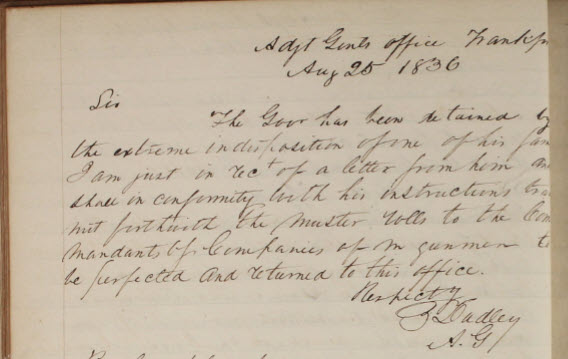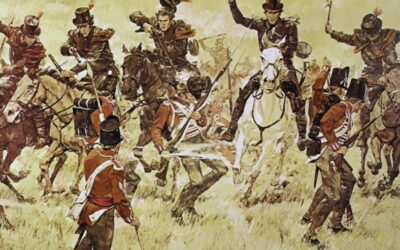For individuals interested in tracing the military history of their ancestors, the National Archives in the United States is a treasure trove of information. The National Archives houses an extensive collection of military records, which can provide valuable insights into the lives and experiences of those who served in the armed forces.
For family historians, these records can help fill in gaps in family trees, shed light on military service, and offer a window into the lives of their ancestors. In this blog post, we will explore some of the military records kept by the National Archives and how they can be used to research family history. In 1976, James Walker of the National Archives addressed the Society about the archive. In this excerpt from his speech, he details some of the military records kept by the National Archives.
War Department Used Cards for Organization
Another important set of records in our custody are records pertaining to the federal Military Service. The records begin with the Revolutionary War, which were abstracted by the War Department and put on cards.
That is, the original records that were examined and all information contained on those original records was abstracted onto a card, the card put in a jacket, and the man’s name, military unit, his rank, when he entered the service, his rank of discharge listed on the envelope. The numbers that appear on that envelope are the numbers that appear on the back of the card, and it is simply an accounting action. It has no reference to military service. They then indexed these records.
One index shows the man’s name, rank when he went in, his rank when he got out, and his military unit. From that you could get the jacket and see what it contains. The other index, called the Special Index, is what we call the Manuscript Records. This card is important only if you are trying to find the record of a person who was not in the military service.
Who am I talking about? I am talking about those officers that are now considered essential and commissioned officers in today’s Army. The chaplains, surgeons, provost marshals, attorneys, dentists—these people were considered support forces therefore, were not enlisted or commissioned into the Continental Army.
This Special Index is the one you use to locate such people.
War of 1812 Records Archive
Records for the War of 1812 are different. You should remember one thing about the War of 1812. Most of the men served for 30 days, 60 days, 90 days, or 120 days. Very few of them served for a year, at least before 1814. Because of this, the average soldier, in the War of 1812, served three, four, or five times. He will have that many records. This means that when you go there, instead of finding ten John Smiths, you will find fifty of them. But don’t get alarmed, just remember what I have said. The average person serves three to five times.
What you should do is get all the records, look at them, and compare them, and any time you find two of them serving simultaneously, then you know they are two individuals. But, in most cases their services will be consecutive so you’ll be able to at least assume that this is the same man serving two, three, four, or five different enlistments, and hopefully, if you’re lucky, you’ll find a pension or bounty land entry to help substantiate that.
Militias Used at End of Revolutionary War
When the War of the Revolution ended, Congress disbanded the army. When there was a need to protect the citizenry, they called out the militia. We have records of those militia services, 1784 to 1811, and we call it the Post-Revolutionary War Period. They are indexed but they do not contain any personal data. They verify that service, and then you can run the next check to see if that man got federal bounty land because of his services.

1836 Letter from the General Adjunct
By federal law all personnel records, including military personnel records less than 75 years of age are restricted by law and are available only to the veteran so long as he lives, or his immediate next of kin.
Better Genealogical Information in Later Records
Beginning in 1893, for the regular army, the physical information paper was at the time of entrance a lot more detailed. And you are fortunate if you have a man in the regular army because one question asked here is “Are your parents living?” If so, where, what is your father’s health, how old is he? The enlistment paper also tells you what unit he was in, when he was discharged, where he was discharged, and why he was discharged.
Then they added another thing, what kind of soldier he was, and the rating was from fair to excellent. If the man wanted to make a career out of the army, he had better be very good or excellent, otherwise he never was allowed to re-enlist.
Finding Officers
For an officer you have a bigger problem. There are 10,201 files. They kept the records given to him in the correspondence file of routine business records of the War Department. Beginning in 1863, they started collecting these records together and making a single file out of them.
Burial Records
Occasionally, we have records which will show when and where a man was buried. These are some of the headstone application records or records of issuing a headstone or a marker for a veteran’s grave.
And you have several national cemeteries in Kentucky, and these graves are all marked, and hopefully, there is a complete record of them. If they are in a private cemetery and there is no headstone on the grave, even today, you may request from the Veterans Administration, a headstone or a marker.
Federal Land Grants
Any man who had served during wartime for the federal government between 1775 and March 3, 1855, was entitled to federal bounty land. Once the request was received at the War Department, they entered it in the book, put the details down concerning it, and then if it were approved, they entered it in another register and told what certificate number was issued, how many acres, and to whom it was sent.
Genealogical Value of War Pensions
War pensions began by appearance in a court, making a declaration. If the pension was approved, the information was forwarded to the War Department. If the War Department approved, the pension begun. Under the various acts prior to 1862, only the soldier or his widow could be pensioned. But beginning in 1862, children, brothers, sisters, mothers, fathers, uncles, aunts, cousins, anybody could be pensioned who could prove that they depended on the veteran for their support.
Another, last point is that the records relating to pension payments prior to 1897 were not a part of the pension file. And this is very important for the Revolutionary War veteran’s pension, in particular, because these records relating to pension payments may tell you who the veteran’s heirs were.
References
- What military records does NARA have?
- Researching the War of 1812: Where to Begin
- Researching Military Records
Editor’s Note
James D. Walker wrote this post for Bluegrass Roots in 1977. At the time, he worked at the National Archives and Records Administration Department.





